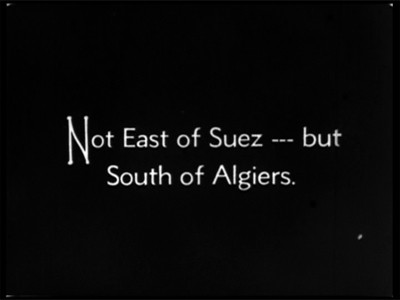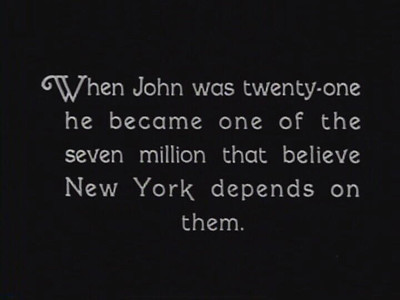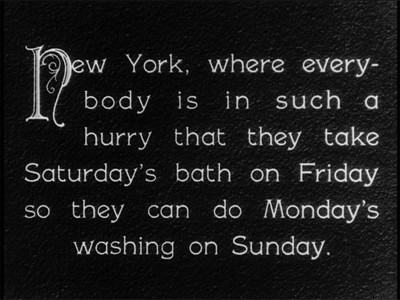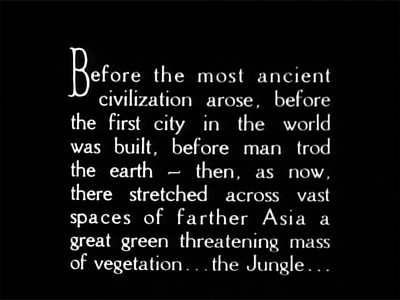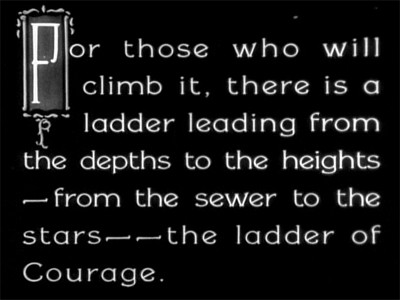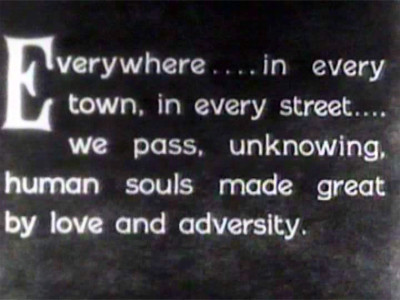Sunday, March 29, 2009
April 3, 1930
Not that that mattered, because the nominees were never announced, just the winners.
It was the first Academy Award ceremony broadcast by radio.
Finally, it was the first of two Academy Award ceremonies to be held that year, so that it might fix itself so that it awarded films that fell in the calender year.
The film world was in a state of trying to find itself again. The introduction of sound crippled the silent industry (though a number of silent films still got nominated that year). People were leaving and entering the film industry at an alarming rate, and what was once box office gold was now ignored while a whole new wave of films began to be noticed.
I'm not sure how much of this chaos effected film availability from that year, but I cannot find any more then six nominees from the 2nd Academy Awards, and I don't know, but that might be for the best. The earliest of sound films were not pretty.
Welcome to the 2nd Academy Awards. What's left of it, anyways.
Wednesday, March 25, 2009
Index: 1st Academy Awards
Winner: Sunrise: A Song of Two Humans (1927) - Fox
Other Nominees:
-Chang: A Drama of the Wilderness (1927) - Paramount Famous Lasky
-Crowd, The (1928) - M-G-M
Best Picture, Production
Winner: Wings (1927) - Paramount Famous Lasky
Other Nominees:
-7th Heaven (1927) - Fox
-Racket, The (1928) - The Caddo Company
Best Actor in a Leading Role
Winner: The Way of All Flesh (1927)/The Last Command (1928) - Emil Jannings
Other Nominees:
-The Patent Leather Kid(1927)/The Noose (1928) - Richard Barthelmess
Best Actress in a Leading Role
Winner: 7th Heaven (1927)/Sunrise: A Song of Two Humans (1927)/Street Angel (1928) - Janet Gaynor (I)
Other Nominees:
-Sadie Thompson (1928) - Gloria Swanson
-A Ship Comes In (1928) - Louise Dresser
Best Director, Comedy Picture
Winner: Two Arabian Knights (1927) - Lewis Milestone
Other Nominees:
-Speedy (1928) - Ted Wilde (I)
Best Director, Dramatic Picture
Winner: 7th Heaven (1927) - Frank Borzage
Other Nominees:
-The Crowd (1928) - King Vidor
-Sorrell and Son (1927) - Herbert Brenon
Best Writing, Original Story
Winner: Underworld (1927) - Ben Hecht (I)
Other Nominees:
-The Last Command (1928) - Lajos Biró
Best Writing, Adaptation
Winner: 7th Heaven (1927) - Benjamin Glazer
Other Nominees:
-Glorious Betsy (1928) - Anthony Coldeway
-The Jazz Singer (1927) - Alfred A. Cohn
Best Writing, Title Writing
Winner: Joseph Farnham
Other Nominees:
-George Marion Jr.
-The Private Life of Helen of Troy (1927) - Gerald C. Duffy
Best Cinematography
Winner: Sunrise: A Song of Two Humans (1927) - Charles Rosher; Karl Struss
Other Nominees:
-The Devil Dancer (1927)/The Magic Flame (1927)/Sadie Thompson (1928) - George Barnes
Best Art Direction
Winners: The Dove (1927)/Tempest (1928) - William Cameron Menzies
Other Nominees:
-7th Heaven (1927) - Harry Oliver
-Sunrise: A Song of Two Humans (1927) - Rochus Gliese
Best Effects, Engineering Effects
Winner: Wings (1927) - Roy Pomeroy
Other Nominees:
-Ralph Hammeras
-Nugent Slaughter
Honorary Award
Awarded to: The Circus (1928) - Charles Chaplin
- For versatility and genius in acting, writing, directing and producing The Circus.
The Jazz Singer (1927) - Warner Bros.
- For producing The Jazz Singer, the pioneer outstanding talking picture, which has revolutionized the industry.
The Lost Films: 1st Academy Awards
Should any of these films become available, I promise to go back and review them.
---
The Devil Dancer (1927)
NOMINATED FOR: Best Cinematography (George Barnes)
Lost film, very little information on it. According to TCM, here's the plot:
"Takla, a white orphan brought up and kept captive in a Himalayan monastery, is rescued by Althestan, an adventurous Englishman who falls in love with her. His sister, displeased with her brother's choice, arranges to have Takla kidnaped. Althestan searches for her and eventually finds her with a troupe of itinerant Muslim entertainers."
---

Gilbert Roland as Johnny Powell in "The Dove"
The Dove (1927)
WON: Best Art Direction (William Cameron Menzies)
Only four reels out of nine of this film exist. You can find them at the Library of Congress. According to Wikipedia:
"Based on a play by Willard Mack, the original story is about a Mexican despot (played by [Noah] Beery), who falls in love with a dancing girl (played by [Norma] Talmadge), who rejects him. Due to the political repercussions of condemning Mexico, it was decided to relocate the plot to some anonymous Mediterranean country."
---

Glorious Betsy (1928)
NOMINATED FOR: Best Writing, Adaptation (Anthony Coldeway)
A partial sound film. Prints exist at Library of Congress, but some of the sound is missing. According to Wikipedia:
"The film is a semi-historical narrative and depicts the real-life courtship, marriage, and forced breakup of Jérôme Bonaparte, brother of Napoleon, and his wife from the American south, Elizabeth Patterson. Napoleon did not approve of the union (despite the fact that her family was one of the wealthiest in America) and the marriage was annulled. Jerome was subsequently forced to marry Catharina of Württemberg. They had one child, depicted in the movie, Jérôme Napoleon Bonaparte. In order to provide a "happy ending", Jerome in the film leaves France to be with his wife. However, in historical fact he remained in Europe."
---

Vilma Banky as Bianca in The Magic Flame (1927)
The Magic Flame (1927)
NOMINATED FOR: Best Cinematography (George Barnes)
Only five of the original eleven reels exist, and they're stored in the International Museum of Photography and Film at George Eastman House Archives. Here's the plot via TCM:
"Bianca, the aerial star of Baretti's circus, loves Tito, the clown, and resents the advances of the handsome Crown Prince of Illyria, who poses as Count Cassati. The prince pursues the wife of a neighboring squire and kills her husband when he discovers them together. Maddened by Bianca's refusals, the prince lures her to his hotel with a forged letter, but she drops from the window, using her gymnastic skill to escape. Tito comes to her aid and in a struggle with the prince casts him from the window into the sea. Bearing a striking resemblance to the prince, Tito assumes his identity and thus evades prosecution. Believing Tito to have been killed by the prince, Bianca leaves the circus to seek vengeance. During the coronation, she is about to assassinate the "prince" when he reveals his identity, and together they escape to the circus."
Here's a copy of the New York Times review of the film that goes into more detail, via a Vilma Bank fansite.
And if you want to go even MORE into detail, here's a novelization of the film, translated from a French magazine.
---
The Noose (1928)
NOMINATED FOR: Best Actor in a Leading Role (Richard Barthelmess)
Prints exist, one at the Museum of Modern Art in New York.
---

Richard Barthelmess in The Patent Leather Kid
The Patent Leather Kid (1927)
NOMINATED FOR: Best Actor in a Leading Role (Richard Barthelmess)
Prints exist. According to Wikipedia:
"[The film] tells the story of a boxer who scoffs at fighting outside the ring... particularly for the United States once it enters World War I. Eventually, he is drafted, is shipped overseas, and performs a heroic act, which results in his being severely wounded."
---

Lewis Stone and Maria Corda in The Private Life of Helen of Troy
The Private Life of Helen of Troy (1927)
NOMINATED FOR: Best Writing, Title Writing (Gerald C. Duffy)
About a half hour of this film exists at British Film Institute archives. Based on the novel by John Erskine.
---
A Ship Comes In (1928)
NOMINATED FOR: Best Actress in a Leading Role (Louise Dresser)
Very little information. Prints seem to exist, but I have no idea where.
---
Sorrell and Son (1927)
NOMINATED FOR: Best Director, Dramatic Picture (Herbert Brenon)
Long thought lost, a partially restored can be found at Academy Film Archive. The film was remade twice, once in 1934 and again in 1984. The plot according to IMDb:
"Stephen Sorrell, a decorated war hero, raises his son Kit alone after Kit's mother deserts husband and child in the boy's infancy. Sorrell loses a promising job offer and is forced to take work as a menial. Both his dignity and his health are damaged as he suffers under the exhausting labor and harsh treatment he receives as a hotel porter. But Sorrell thrives in the knowledge that his son will benefit from his labors. Sorrell has allowed the boy to believe his mother dead, but when the mother shows up, wanting to re-enter the young man's life, Sorrell must make hard decisions."
---

William Boyd, Mary Astor and Louis Wolheim in Two Arabian Knights
Two Arabian Knights (1927)
WON: Best Director, Comedy Picture (Lewis Milestone)
Long considered lost, a complete print was recently found and aired on Turner Classic Movies. There's a good chance I'll get to review this one in the future. Plot according to IMDb:
"Two American soldiers are captured by the Germans on the Western Front during World War One and escape a POW camp only to stumble into further life-threatening adventures when they come across an Arabian king's daughter while on the lam."
---

Evelyn Brent and George Bancroft in Underworld
Underworld (1927)
WON: Best Writing, Original Story (Ben Hecht)
This film still exists, but isn't available on DVD, and I haven't been able to find a copy of the VHS. It still gets screened at museums occasionally. I'll probably be able to review this in the near future. The plot according to IMDb:
"'Nobody helps me -- I help them!' boasts open-handed gangster Bull Weed, handing over what will prove to be the best investment in his high-spending career: a thousand dollars that will put the literate 'Rolls Royce' of vagrants back on his feet. Living it up in the Twenties with the aid of cool but smouldering moll Feathers, the Bull lords it over the law and his rivals alike -- specifically big Buck Mulligan, whose floral-tributes business echoes that of a certain real-life Chicago gangster... Yet Feathers, prize possession and object of envy, proves his weak point; and in the end, Bull Weed will indeed come to need help from others, and more than he has ever needed it before. But can Rolls Royce and Feathers still give it to him? And will the Bull accept?"
---
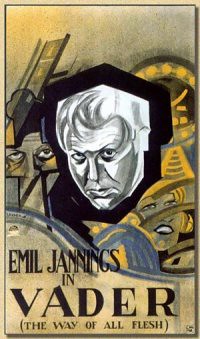
The Way of All Flesh (1927)
WON: Best Actor in a Leading Role (Emil Jannings)
This film is lost. It was remade in 1940. Here's the plot of the 1940 version according to IMDb:
"Paul Kriza is a cashier of a bank in a small town, and the happy husband of Anna and the father of four children. He is sent to New York to deliver some securities for the bank. There, he is tagged as easy-pickings by a con-game gang and Mary Brown, gang accomplice, proves he is. Waking up in the morning he discovers he has been robbed of the securities and, when he confronts the gang, he is hit on the head and taken out to be left on a railroad track. He comes to, struggles with the henchman and the man is killed when a train comes roaring by. Paul escapes but his watch is found and he is reported as the dead man. But he can't go home again."
Here is my review of The Last Command, the other film that won Emil Jannings the Oscar.
Tuesday, March 24, 2009
REWIND, FAST-FORWARD and INTERMISSION
REWIND: Should I review a film from a past Academy Award that wasn't available at the time but has become available.
FAST-FORWARD: Should I review a film from a future Academy Award for some reason.
INTERMISSION: Posts that have nothing to do with Academy Award nominated films.
Hollywood and The Jazz Singer


The Jazz Singer (1927)
DIRECTED BY: Alan Crosland
STARRING: Al Jolson, May McAvoy, Warner Oland
WON: Honorary Award (For producing The Jazz Singer, the pioneer outstanding talking picture, which has revolutionized the industry)
NOMINATED FOR: Best Writing, Adaptation (Alfred A. Cohn)
Lately, I've been blind-sided by the state of life. At this time last year, I was far less concerned about my economic status, far less concerned about if my car was functioning correctly, far less concerned about the policy changes at my job. The things I was more concerned about I've almost completely forgotten.
I've been in so many good places in my life, and inside I'd beg for things to stay this way. Change is almost nothing but destructive. Change kills many great things.
The Jazz Singer carries the stench of death...
*snicker*
Sorry, I'm being corny. As much as I want to make The Jazz Singer out as a Hollywood serial killer who killed the era of silent films and more then half of the people involved, it'd be closer to the truth to call it some mentally handicapped guy who accidentally ran over the silent film industry with his parent's car. It's fame and infamy are purely by chance, and not at all earned.
The Jazz Singer was not the first sound film. Thomas Edison managed to sync sound almost right after inventing film, and the twenty years before The Jazz Singer led to dozens of examples.
The Jazz Singer was not the first full-length film with sound. Don Juan came out a year earlier with a synced music soundtrack and sound effects. Sunrise came out a month earlier, also with music and soundtrack, and even background dialogue.
The Jazz Singer was not the first full-length film with synced dialogue. For the most part, it's a silent film, intertitles and all, with dialogue only popping up in two scenes. The first "talkie" wouldn't come for another year, in the form of Lights of New York.
The Jazz Singer was not made with the most innovative technology available. Fox Studio's sound-on-film system surpasses Warner Bros' sound-on-disk system in just about every way. Sound-on-film didn't get unsynchronized, it didn't wear out nearly as fast, and it allowed for more portable cameras.
The Jazz Singer was not a good film. Not in the slightest. Some people are still rolling their eyes over it's high melodrama and over the top acting. It's the worse film I've reviewed thus far.
The Jazz Singer is not a comfortable film. Even ignoring it's history as a silent film killer. I don't care how often you say "that was just how things worked back then," the famous blackface scenes make my stomach turn. Less talked about is the film's strong Jewish stereotype. There isn't as many numbers on just how offensive Jew stereotypes are, but this film like two kinds of uncomfort sandwiching some cheesy old musical numbers.
The Jazz Singer was merely the first successful film with some sound in it. And, I guess, that's all it took to kill silent pictures.
And with this, we finish the 1st Academy Awards. The film industry would recover eventually. It's like a phoenix, it becomes reborn in it's own ashes. Unfortunately, ashes are all we have to look at as we enter the 2nd Academy Awards...

Friday, March 13, 2009
Hollywood and Wings
Wings (1927)
DIRECTED BY: William A. Wellman
STARRING: Clara Bow, Charles 'Buddy' Rogers, Richard Arlen
WON: Best Picture, Production
Best Effects, Engineering Effects (Roy Pomeroy)
I feel that I should have something more engrossing to say about this film. After all, it's a "first," and society loves firsts for some reasons. Thing is, first never means special, and first never means best. For their to be a first, there must be a second to best it, and a third and a fourth. There are many Best Picture winners that are better then Wings. In fact, most of them are, and being first doesn't change that one bit.
Wings isn't a bad film, don't get me wrong. It's just... standard. Even the films I've given generally negative reviews have had several interesting elements to them that make them stand out. Wings has some technical innovations, but it's story and "message" come off as a-typical Hollywood plodding.
We got a boy...

He's got a dream, see. He wants to fly in dem new spangled air-o-planes!
We got a girl...
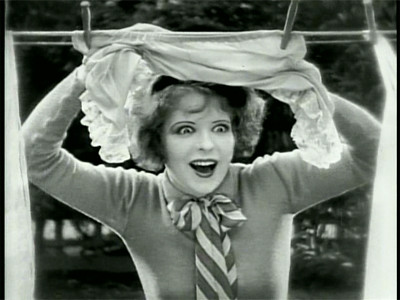
She's the girl next door, and she's got a big ol' crush on the boy! But the boy, he loves another girl...
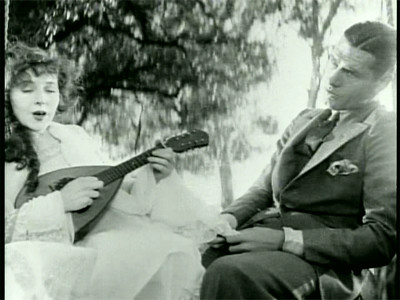
But this other girl is in love with the local rich kid, also pictured. We get some standard push-me-pull-you dinking around that would probably continue forever, if not interrupted by...
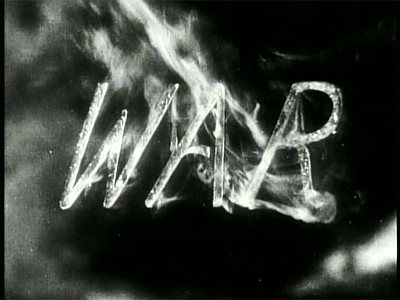
GOOD GOD!
WHAT IS IT GOOD FOR?
ABSOLUTELY NOTHING!
So, the boy and the rich kid go off to war, where they meet Goofy Comical Relief...
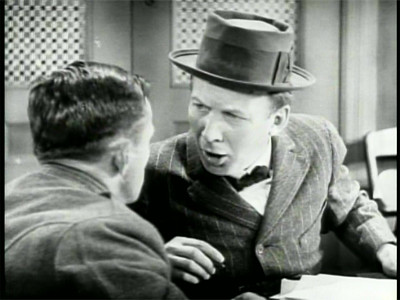
While he's a citizen, he comes from a German family, so nobody trusts him! Until he waves around his tattoo, that is!

So, our trio go to boot camp. Cue boot camp hijinks.

They even have an always-angry drill sergeant!
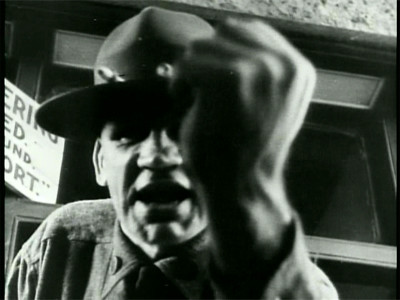
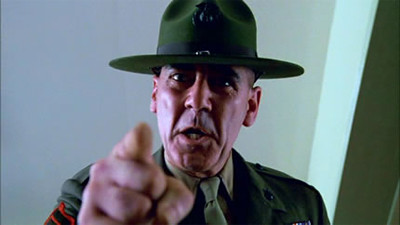
Ok, I'm starting to sound demeaning, but we've all been here before, dozens of times. I'm not sure how fresh all these tropes were at the time, I'm not that well versed in film history (yet), but I do know they were done to death afterwards, and almost never done by classy films. I'm talking about Pearl Harbor and Top Gun kind of unclassy.
It amazing how, right off the bat, the Academy gave the award to something standard and boring over fresher and more artistic films. The people may have changed, some of the categories may have changed, but the Academy? The Academy is forever.
Another thing about this film being the "first" is that it's talked about to death, so everything I'm about to praise this film for has been talked about to death. When people talk about Wings, they always talk about Gary Cooper.
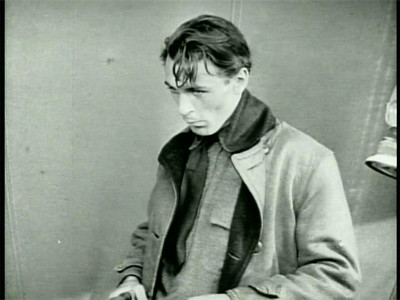
Cooper plays a fellow pilot who bunks with our main characters for all of two minutes. During that time, he delivers a bit of wisdom about how good luck charms don't really mean anything, that when death is knocking at your door you're gonna answer no matter what. Then Cooper's character leaves for a training mission, has an accident, and dies off-screen.
It's a fleeting moment, and the only real time the film transcends itself. Despite still being wet behind the ears at this point, Gary Cooper is clearly a subtle and talented actor, which gives the moment much more weight. It gives the scenes that follow an eerie feeling to them. Unfortunately, the movie goes on too long after, with too many scenes unrelated to the war (including a horrible set of scenes where one of our main characters chases imaginary bubbles... uh, don't ask), so by the final moments of the film, when Cooper's words would have resonated the hardest, they're all but forgotten.
The film's other big plus is the flying.
There were no models, so CGI, no stop motion, simply no special effects that could simulate flight at that time. So, when you see airplanes take off...
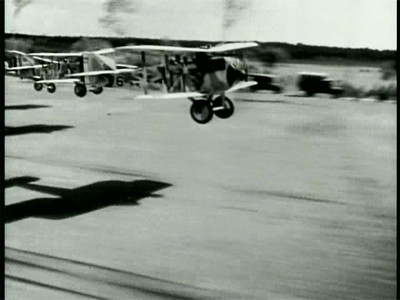
Airplanes in the air...

And even airplanes crashing...

You're seeing the real thing! These moments are really what make Wings worth watching. Sometimes it's nice to be reminded just how sedated on computer generated images were are, and just how thrilling the real thing actually is.
I really wish I had more to say, I really do. I wanted to do a huge, perhaps multi-article breakdown of the film, but I came up with nothing besides what I've just shown you. Wings is standard, that's all there is to say.
Firsts aren't always that important, I guess.
However, We're still not done with the 1st Academy Awards yet. There's one more film to look at, one that changed the face of film more then all the films reviewed so far put together, even if it didn't win the top prize.
You ain't heard nothing yet.
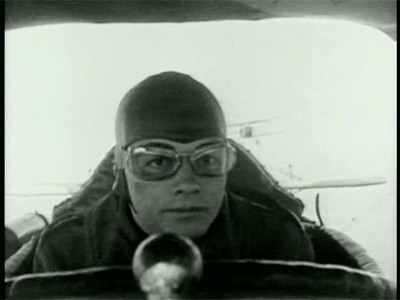
Tuesday, March 3, 2009
The Fairbanks/Pickford/Chaplin/Griffith Connection
 From left to right: Douglas Fairbanks Sr., Mary Pickford, Charles Chaplin and D.W. Griffith, around the time they founded United Artists in 1919. What did these four talk about on their off time?
From left to right: Douglas Fairbanks Sr., Mary Pickford, Charles Chaplin and D.W. Griffith, around the time they founded United Artists in 1919. What did these four talk about on their off time?

Was D.W. Griffith the alpha male in the group? His hat says yes.
By the way, for those who like their Oscars (and if you're here, that's probably what you came for), Nathaniel has teamed up with Mike from Goatdog's Movies and Nick from Nick's Flick Picks have been running a feature comparing the Academy Award winners for Best Picture from the outside in, aptly titled Best Pictures From the Outside In.
Check it out, and check out the Film Experience blog in all it's nifty photoshoped glory. Though, considering my first audience will probably come from there for this picture challenge, I think I just created a mobius strip. Enjoy clicking links forever! HAHAHA!
Where can I get one of those alpha male hats?
Monday, March 2, 2009
Let's Talk Intertitles
However, little attention is given to the OTHER award that was only given out at the 1st Academy Awards: Best Writing, Title Writing, awarded to Joseph Farnham, for no film in particular. 1929 officially marked the end of silent pictures. A demand for sound forced Hollywood and filmmakers to start from square one, 20+ of progress tossed in the trash by a humble blackfaced jazz singer. They had find new ways to shoot, new ways to act, and new ways to be artistic. And intertitles disappeared for good.
It's hard to imagine what films would look like if the silent era had been allowed another ten or twenty years to itself. Silent television, now that would have been something.
People rarely talk about intertitles, even when talking about silent films, but they were developing along with the rest of the film industry. Many great films didn't just have their intertitles reveal dialogue. They used artistic language to set moods that couldn't have been found with simple lighting and sets. And the actual intertitles, the screens themselves, began exploring new ways to present themselves.
Not all intertitles were simply white text on a black background. Take a look at some of these, from 1921's The Sheik:
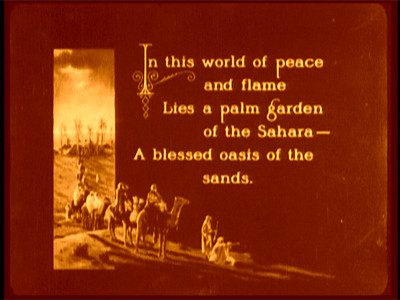


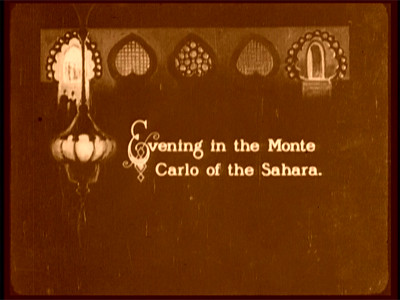

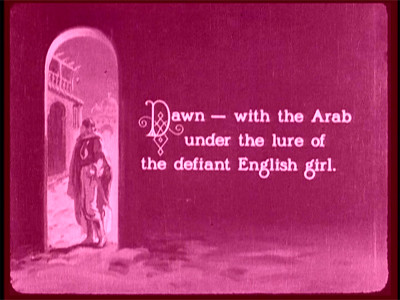


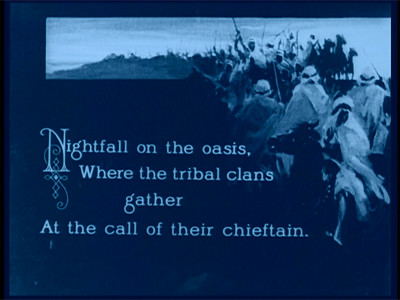

That's what we lost people. Awesome stuff like this.
Another artistic aspect intertitles had were their physical relation to the film itself. My favorite use of intertitles in all the films I've reviewed so far comes Sunrise. The film's story is simple and the acting is a bit blunt and direct, but Murnau's use of images adds subtextual layers in the film in ways you wouldn't see anywhere else. That goes for the film's intertitles as well, which are used in a very unique way.
Take this scene. Neighbors to the husband and wife characters are discussing the two's marital problems. One of the the neighbors says this:

Then, we fade into a flashback of happier times...

Fine enough. Usually we'd cut to the next scene, probably back to the neighbors, but instead...

We fade back to the same intertitle. What we just witnessed was the thoughts and memories behind this dialogue, encased completely in it, and it works great. Also, it's an idea you couldn't pull off in sound. Imagine if someone was talking, and in the middle of their sentence we fade to a flashback for a minute, then fade back to see the original speaker finish their sentence. It would seem awkward at best, bad editing at worst.
When the husband and the woman from the city are making near the lake, the intertitles take on the devilish qualities of the surrounding mist.
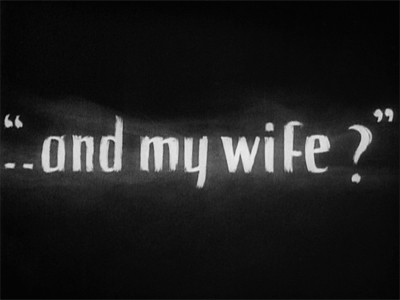
My favorite intertitle moment ever comes in this scene. The woman from the city offers a suggestion to the husband about what to do with his wife.

We hold on this for a moment, unsure of what evil thing our antagonist is going to suggest. Then, it fades in.

This thought then literally sinks into the husband's mind...

After sinking it, the idea plays out in the husband's head, words turned into actions...

Intertitles had only just started getting used in these unique and interesting ways when sound showed up and ruined all of that.
So, please, when you go to bed tonight, say a little prayer for intertitles.
To close, here's a collection of some of my favorite intertitles from films previously reviewed. Can you guess which film goes to which?

